Even 40 Years After Cult Classic ‘Streets of Fire’ Hit Theaters, Star Michael Paré Still Has Secrets to Share
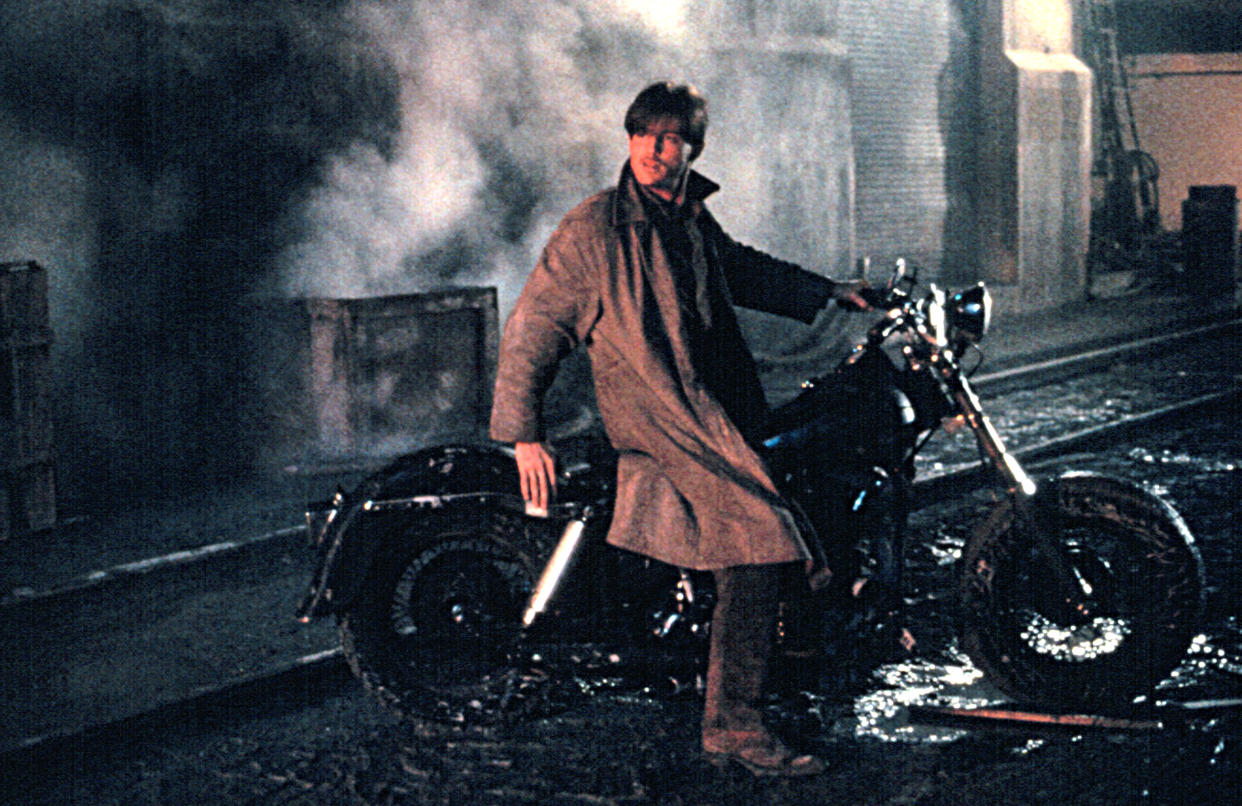
This year gifts us the 40th anniversary of the major motion picture “Streets of Fire.” In 1984, Walter Hill’s ambitious “rock & roll fable” sported a killer soundtrack and an all-star cast, how could it possibly have failed? Oh, right, it was released against both “Indiana Jones and the Temple of Doom” and “Star Trek III: The Search for Spock” (the summer of 1984 was stacked). And that aforementioned all-star cast? Including Diane Lane, Willem Dafoe, Rick Moranis, Bill Paxton, and Amy Madigan? None of them were famous yet. (Even Moranis was still best known for being a cast member on “SCTV,” as eventual hit “Ghostbusters” was still a few weeks away from release.)
But, over the past 40 years, Hill’s “Streets of Fire” has developed quite a robust following. (In 1984, its biggest cultural footprint was probably the song “I Can Dream About You,” performed by fictional group The Sorels in the film and Dan Hartman in reality, which peaked at number six on Billboard’s Hot 100 and got extensive play on MTV.)
More from IndieWire
The plot? Well, describing the plot of “Streets of Fire” tends to make the person doing said describing sound a little, let’s say, eccentric. Here goes anyway: Set in “another time, another place,” a lot of the fashion and surrounding environments make the movie look as if it was set in the 1950s; at other times, with a lot of pink neon signs, it very much resembles the 1980s. The dastardly bike gang leader Raven (Dafoe) has kidnapped pop superstar Ellen Aim (Lane). Reva Cody (Deborah Van Valkenburgh, who was also in Hill’s “The Warriors”) knows only one man can help … her brother, Tom Cody.
Tom Cody — played by Michael Paré, best known at the time for playing wiseacre Tony on “The Greatest American Hero” and Eddie Wilson in “Eddie and the Cruisers” — is a man with a past. A former lover of hometown heroine Ellen, Cody walks into town, defeats a gang of greasers barehanded, then assembles a rag tag crew to rescue Ellen. Cody recruits her manager and current boyfriend, Billy Fish (Moranis, playing a character in which his every word is lathered with contempt), and a drifter named McCoy (Amy Madigan). This all culminates in a street brawl between Tom Cody and Raven involving sledgehammers, because honestly, why not?
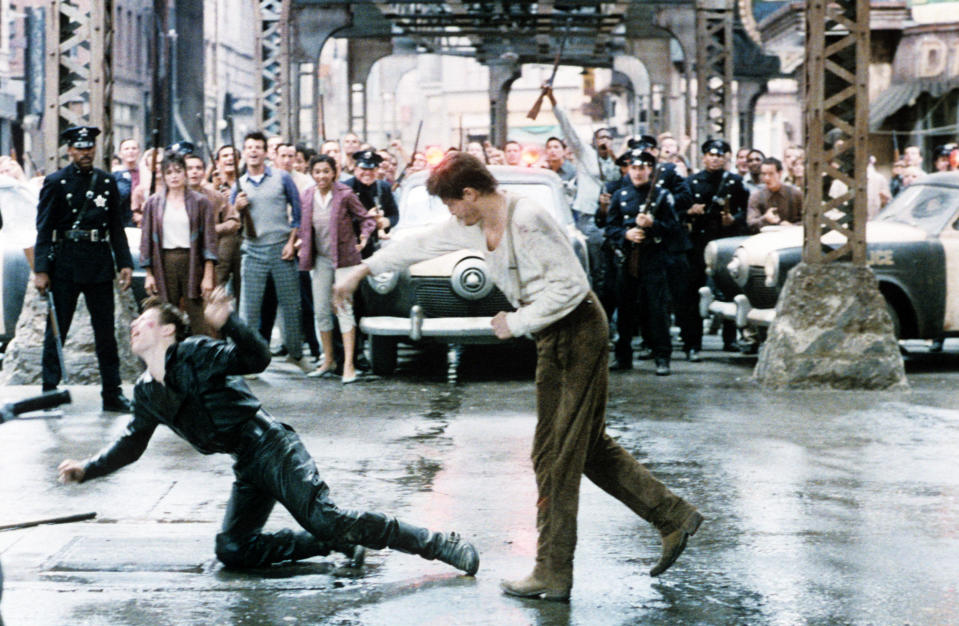
To commemorate the 40th anniversary of “Streets of Fire,” who better to talk to than Tom Cody himself, Michael Paré? In speaking to Paré, it’s very evident how much he still loves the film, and he has a lot to say about it. In general, yes, but also when it comes to the multiple times he risked his well-being for the sake of this movie; the original ending that would have drastically changed the plot of the film; and his, let’s say, fraught relationship with Rick Moranis on set.
Oh, and then there’s the whole issue about the unauthorized sequel he says he was tricked into filming. (It’s on YouTube and I could only make it through five minutes.)
And as it turned out, on the day I spoke to Paré, “Streets of Fire” was making the rounds on social media after Austin Butler mentioned it during his press tour for “The Bikeriders.”
IndieWire: “Streets of Fire” is all over social media today. Did you see that?
Michael Paré: No, not yet. It’s only 10 o’clock here.
Austin Butler is promoting “The Bikeriders” and mentioned “Streets of Fire” as a movie he watched to prepare for the role.
Oh, right! How cool is that? I’m a big Tom Hardy fan.
I’m glad they watched “Streets of Fire.“
Me, too. Me, too. I get a lot of fan mail from Japan about “Streets of Fire.” They did a big re-release and the 40th anniversary Blu-ray and all that stuff. They brought me over for the first Tokyo Comic-Con since the pandemic, just for “Streets of Fire.” What’s funny is, it was enormously successful everywhere but the United States. It opened opposite “Indiana Jones and the Temple of Doom,” I think. And all the guys who made it left Universal and went to 20th Century Fox, so they abandoned the project. Anyway, it’s funny the Japanese loved it and send me fan mail about it. Anyway, you’ve got questions…
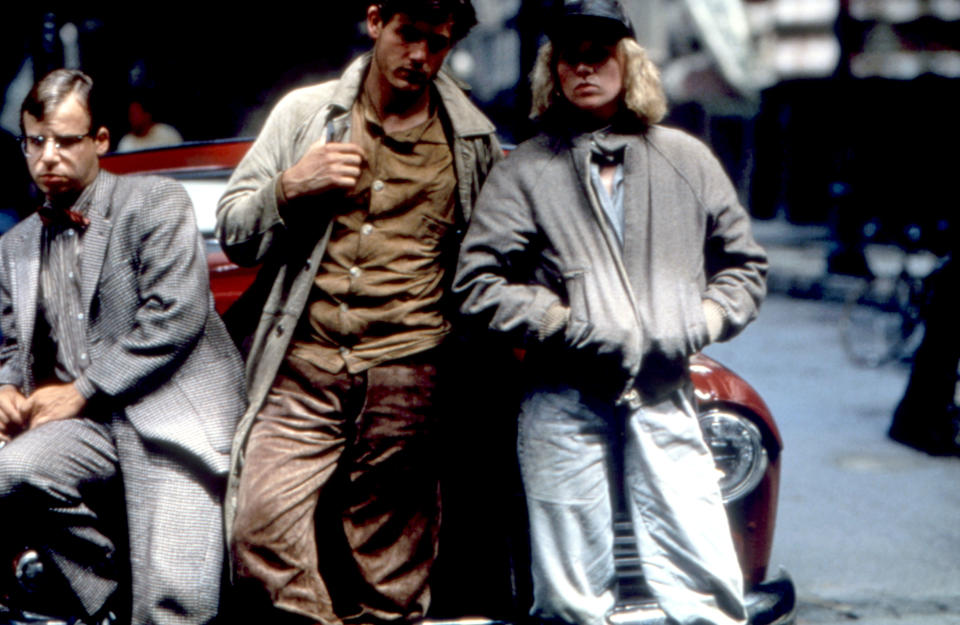
No, I want to hear all this. But I will say, even in the United States, people eventually caught on. People love this movie now.
And the soundtrack was just incredible! And the cinematography? Andrew Laszio would light for seven to eight hours.
I don’t doubt that.
It was just amazing. And Walter? If I were to describe Walter Hill, I’d say he was kind of like Jack London. He was like Tom Cody! He doesn’t say much, it’s already on paper. It was a long time ago, but it seems like yesterday. You know, I had never ridden a motorcycle.
Wait, what?
There was a lot of magic on “Streets of Fire.” I say magic because there’s no explanation for why it worked. The day before, I had to ride a motorcycle in Chicago. I really didn’t know anything about motorcycles. They took me out on a motorcycle that night and I’m just riding around in the alleys in Chicago and I had never been on a motorcycle.
I’ve never been on a motorcycle. It seems like a hard thing to do.
So this is the story. The night before I got to ride it a little bit and learned how to pull in the clutch so I could brake — use the back brake, don’t use the front brake. I had to ride down this hill and turn to set, this pull this U-turn in the middle of the crew. And the crew is 75 people! So it’s a big crew! And Diane Lane and Rick Moranis and Amy Madigan are there waiting for me. And I had to do this maneuver and, wow, it’s like landing an F-16 on an aircraft carrier, in my mind. And I just got it right the first time! And I was like, fuck! How did that happen? Because I had no experience! After that I got more comfortable, but it really was magical. So, that burgundy Mercury? I had never driven a stick before!
Now that I’ve done. And it is difficult the first time.
There’s one more moment … well, there are a few actually. It’s the part where Stoney Jackson is driving the school bus with the The Sorels? This is an actor driving a school bus! Which is also a standard transmission. I had to step in front of the bus and put my hand up to stop him. And I’m thinking, fuck man, this is dangerous. I was like, “Walter?” And he says, “Just stand there, don’t worry.” And I said, “OK, fine, I’ll do it.” He says, “Just hit your mark and don’t worry.” So, they say action and the bus is coming around the corner and it’s coming toward my mark. I step out, put my hand up, and it’s just this feint moment when Stoney steps on the brakes and it looked like I stopped the bus with my hand! My hand was on the bus and I didn’t move. It looked like a Superman move!
This all sounds very dangerous.
It was! “Streets of Fire,” man, four years before that I was working in a kitchen off of 14th Street, 65 Irving Place. And I went from there, boom, to “Streets of Fire.” I had done “Eddie and the Cruisers” and the movie of the week with Ray Liotta and David Caruso. [A movie called “Crazy Times,” which IMDb says “Follows the exploits of three teenage friends sharing the good times back at Rockaway Beach, Queens, New York during the summer of 1955.”] Ray Liotta, rest his soul. I think that was David’s first movie, I was doing “The Greatest American Hero” and Ray was doing a soap opera. The early ‘80s were magic for me. I landed on another planet called Hollywood.
You mentioned the magical times, were there other times you questioned what on Earth even is this movie? When I try to describe it to someone who hasn’t seen it I sound like a crazy person.
It’s like an alternate reality. I don’t know if you read Marvel comics…
I do.
It’s like a Marvel alternate reality story. It’s post-apocalyptic, but things are not so bad! We’ve got rock n roll, we’ve got beautiful chicks, fancy cars, and motorcycles. It’s not “Mad Max” where it’s the end of reality. It’s an alternate reality. And the music was great, come on. I was so focused on just being Tom Cody, in the character. Like Diane as Ellen Aim? She was from another planet. The post-apocalyptic world was not so bad because we had Ellen Aim. Everybody was cool because we had cool music and cars. You didn’t worry about, How did they feed themselves? How did they make a living?
You know, Wild Bill. Bill Paxton, that was one of his early parts. And I remember hanging around waiting for them to shoot, and Bill says, “What is a cool thing to say when you walk in?” I said, “What do you mean?” He said, “I don’t want to say hey, how are you doing, Tom Cody?” I said, “Hey, Tom, how’s your hammer hanging?” And he puts it in the movie! I show up and he had that fake tooth to put in. He was a very smart actor. He knew how to work the camera and work the scene and be outstanding.
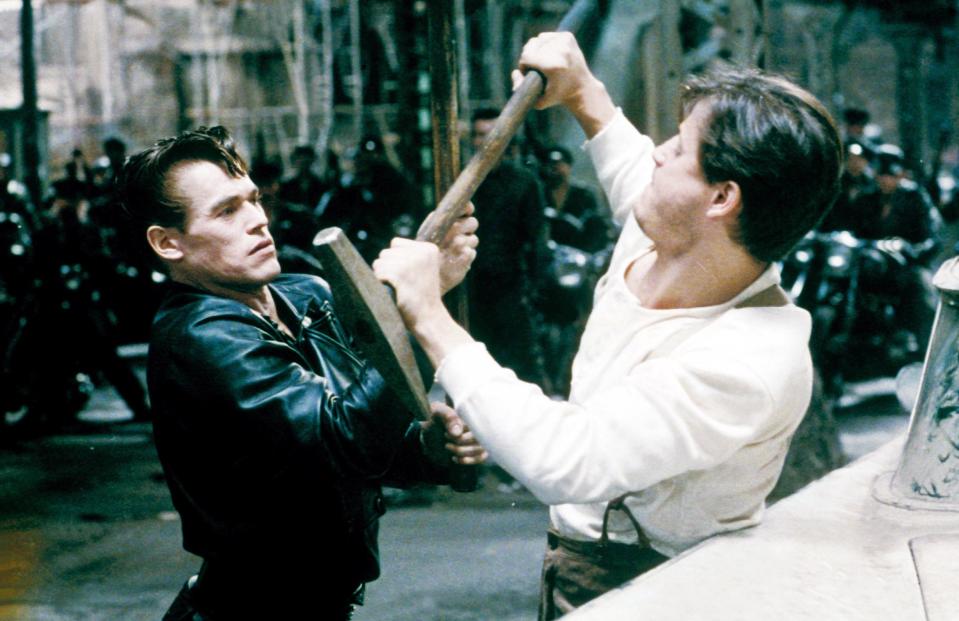
I’m a big fan of Tom Cody’s entrance in the movie, when he disarms a greaser with a knife, does a trick with it, then hands it back to the greaser to try again.
See, that’s something I learned how to do a few hours before we shot it. That whole trick with the butterfly knife? It was somebody who was related to Bruce Lee was one of the stuntmen and he showed me how to do it. Working in the kitchen, during downtime, we could take a steak knife, toss it across the room and stick it into a potato. So, I was pretty handy with a knife. But learning how to do the butterfly thing was like, hmm. It took about 15 or 20 minutes, then I was making it up as I went along. Do you know why they call it a butterfly knife?
No.
Because the prostitutes in Thailand and Vietnam, they carried those. The girls weren’t butterflies, but if the boyfriends cheated on them, they were called butterflies. Because they go from flower to flower.
Oh.
So that’s what the girls would stab their boyfriends with.
Wow … OK. I have never heard this.
They don’t want to kill them. They wanted to warn them. You don’t want to be a butterfly with a girl who carries a knife [laughs].
Take me through your hammer fight with Willem Dafoe.
Yeah, that, the hammer head was aluminum, so it was still something you could hurt someone with. The hammer fight, it was hard wood handles with aluminum heads. And they let me and Willem do this stuff! I remember I touched his nose once with the handle. But he didn’t question it and the next take I’d do it again. We rehearsed, then we shot with me and Willem for two weeks. Then they did another week with stunt guys, like second unit. But I had a great time doing that stuff. You show up, you stretch out. It was fun stuff.
When Willem Dafoe does that famous scream, what are you thinking?
[Laughs] I thought I could put one right on his chin! You don’t want your mouth open in a fight. When he yells and charges at me, I’m thinking, If I could just put it right on his chin, it would be all over.
But then the movie ends early.
Here’s something not everybody knows. In the original script, Willem is kicking my ass. Well, Raven is kicking my ass. And I pull a knife out of my boot and I stab him and kill him. That was in the original script. When we got to Hollywood, they said, “Wait a minute, there’s a much bigger audience who would appreciate it if you don’t kill him.” In Walter Hill’s draft, it’s “don’t lose at all costs.” That was the undercurrent. When they took that knife out where I kill him, it changed the whole story and the whole character. It added honor and nobility to Tom Cody instead of just a guy who will not fucking lose.
There’s a scene in which Ellen is going to go to the fight but Tom Cody thinks it’s too dangerous…
And he knocks her out.
Yes, what was the discussion around that scene at the time?
That was in the original script. The other thing, that was the first time I kissed a girl on film, is with Diane Lane. It was my first love scene. Everybody is like, “What was it like to kiss Diane Lane?” I said, once our lips touched, the movie wasn’t there. But thinking about it, it was like, holy shit, this girl has been on Broadway, she’s worked with Laurence Olivier. This is the consummate actress. And she walked with such confidence. Only she could get away with that. And she did it with such confidence! And she’s, what, 18 years old? She turned 18 on that movie. They delivered her report card from high school.
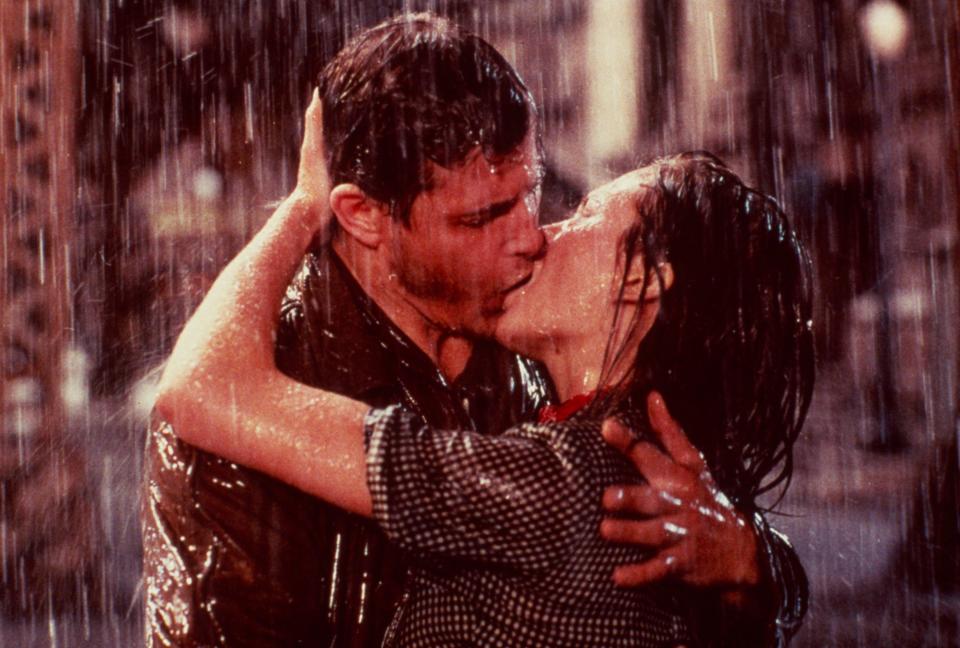
I’ve read your quotes about your relationship with Rick Moranis on set. [In 2011, Paré was quoted as saying, “Rick Moranis drove me out of my mind.” Adding, “He would imitate me. The first thing he says to me is, ‘Do you just act cool, or are you really cool?’ That was the first sentence out of his mouth to me in Joel Silver’s office. And I was like, ‘Oh fuck, this is not going to go well.’”]
Look, that got so blown out of proportion.
OK, then that’s what I want to hear about.
In real life, wise guys, they get two chances to say something to you, then you can smack them in real life. Right? But Tom wasn’t allowed to do that. So, Rick could really get me wound up, to the point I couldn’t hit him. And he’s a comedian! There are a couple lines in the movie where he calls me “lunkhead” or “musclehead” or something like that. In the movie I couldn’t hit him. But in real life, if somebody does that to me? But in the movie, he’s not allowed to because it’s not in the script.
To be fair, it does fit the character of Billy Fish. Today, people aren’t used to seeing Rick Moranis play a character like that. It’s startling.
Yeah, he had a great costume. He had extra padded shoulders. He was a funny guy! And it turns out he was a very noble guy.
What do you mean by that?
Well, I think his wife died and he raised his kids by himself. And he stopped working for a few years. And hey, he’s very funny. I saw his stuff on “SCTV.” “Hey, hose off, eh?” Comedians are funny people because they risk it all.
I can’t help but think, he’s a young actor at the time, too. “Ghostbusters” wasn’t out yet. He probably also feels he has something to prove. And maybe that heightened some things?
You know, in reality, the Billy Fish character would have been slapped really hard a few times. In the script, that doesn’t happen. If I beat up Ellen Aim’s boyfriend, it would have been wrong. It forced him to be the grownup. Smacking him, people would have been like, why are you beating up the little guy? Even if I just slapped him once! When he wants to pay me, and I through the money at him and I walk out of the hotel and Diane runs after me and kisses me? If I had slapped him instead of throwing the money in his face, she wouldn’t have ran out of the building and kissed me. Walter Hill is not a guy who says, oh what the fuck, let’s see what happens. He thought about this very long and hard. So, I really had to surrender to Walter and the process.
I’m fascinated that “Road to Hell” exists.
Ha. So, this guy!
Albert Pyun?
He says he got permission from Walter. Also, it was a 20-minute thing, originally. It was right after that movie, it was kind of like a comic book? Mickey Rourke was in it?
Oh, “Sin City.“
Yeah! Yeah. So, it’s a couple years after that came out, so it’s a whole new kind of movie. So, this guy came to me and said that he did have permission from Walter and Joel Silver and Larry Gordon. I was like, alright. Then we do the 20-minute thing and I’m thinking it would be like a comic book, like “Sin City.”
He called me up, “Mike, we have this girl who’s going to do a Diane Lane imitation.” And I’m like, “And this is alright with Walter and Universal?” He said, “Yeah yeah yeah.” And he was just lying and lying and lying. I think I was on it for five days. And it was a complete fuck up. I’m kind of ashamed I didn’t call Walter and say, “Walter, is this OK?” But Deborah Van Valkenburgh was there also. So, I thought, Alright, it must be on the up and up. Deborah is a very honorable and noble person also.
And Albert Pyun directed some real movies. He directed “The Sword and the Sorcerer,” which was a movie people knew pretty well in the ‘80s. So I understand why you’d believe him.
Yeah, hey, they were always talking about doing two others. The next one was supposed to be in the desert. Then the next one was going to be in the tundra. Like in the icy cold land of outside of Russia or Canada or something like that. And I wasn’t with the same agents, so they couldn’t check on it. So, I show up on this soundstage and it’s going to be like “Sin City.” I said, alright, I’ll see what the fuck is going on here. And that was it. I think this guy died recently.
He did. In 2022.
He’s dead.
That story is crazy. I didn’t realize you were lied to.
Yeah, well, you know, also, I wanted to believe. I wanted to believe. That’s an issue when you’re in Hollywood. People come to you with ideas and you hear what you want to hear and you want to believe it’s true and you don’t find out until it’s too late.
Best of IndieWire
The 30 Best Nude Scenes in Film, from 'Shortbus' to 'Blue Velvet' to 'No Hard Feelings'
The 15 Best Thrillers Streaming on Netflix in July, from 'Fair Play' to 'Emily the Criminal'
Sign up for Indiewire's Newsletter. For the latest news, follow us on Facebook, Twitter, and Instagram.
